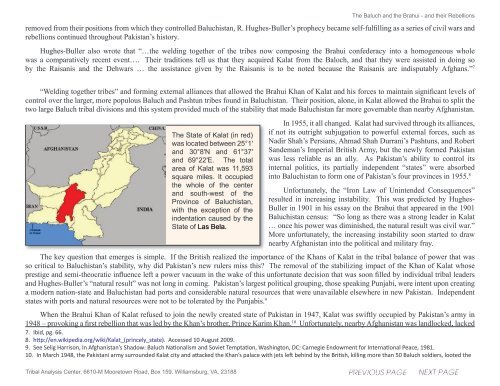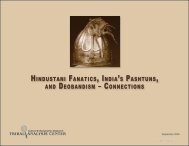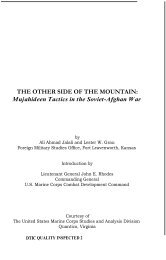the baluch and the brahui and their rebellions - Tribal Analysis Center
the baluch and the brahui and their rebellions - Tribal Analysis Center
the baluch and the brahui and their rebellions - Tribal Analysis Center
Create successful ePaper yourself
Turn your PDF publications into a flip-book with our unique Google optimized e-Paper software.
The Baluch <strong>and</strong> <strong>the</strong> Brahui - <strong>and</strong> <strong>the</strong>ir Rebellionsremoved from <strong>the</strong>ir positions from which <strong>the</strong>y controlled Baluchistan, R. Hughes-Buller’s prophecy became self-fulfilling as a series of civil wars <strong>and</strong><strong>rebellions</strong> continued throughout Pakistan’s history.Hughes-Buller also wrote that “…<strong>the</strong> welding toge<strong>the</strong>r of <strong>the</strong> tribes now composing <strong>the</strong> Brahui confederacy into a homogeneous wholewas a comparatively recent event…. Their traditions tell us that <strong>the</strong>y acquired Kalat from <strong>the</strong> Baloch, <strong>and</strong> that <strong>the</strong>y were assisted in doing soby <strong>the</strong> Raisanis <strong>and</strong> <strong>the</strong> Dehwars … <strong>the</strong> assistance given by <strong>the</strong> Raisanis is to be noted because <strong>the</strong> Raisanis are indisputably Afghans.” 7“Welding toge<strong>the</strong>r tribes” <strong>and</strong> forming external alliances that allowed <strong>the</strong> Brahui Khan of Kalat <strong>and</strong> his forces to maintain significant levels ofcontrol over <strong>the</strong> larger, more populous Baluch <strong>and</strong> Pashtun tribes found in Baluchistan. Their position, alone, in Kalat allowed <strong>the</strong> Brahui to split <strong>the</strong>two large Baluch tribal divisions <strong>and</strong> this system provided much of <strong>the</strong> stability that made Baluchistan far more governable than nearby Afghanistan.The State of Kalat (in red)was located between 25°1′<strong>and</strong> 30°8′N <strong>and</strong> 61°37′<strong>and</strong> 69°22′E. The totalarea of Kalat was 11,593square miles. It occupied<strong>the</strong> whole of <strong>the</strong> center<strong>and</strong> south-west of <strong>the</strong>Province of Baluchistan,with <strong>the</strong> exception of <strong>the</strong>indentation caused by <strong>the</strong>State of Las Bela.In 1955, it all changed. Kalat had survived through its alliances,if not its outright subjugation to powerful external forces, such asNadir Shah’s Persians, Ahmad Shah Durrani’s Pashtuns, <strong>and</strong> RobertS<strong>and</strong>eman’s Imperial British Army, but <strong>the</strong> newly formed Pakistanwas less reliable as an ally. As Pakistan’s ability to control itsinternal politics, its partially independent “states” were absorbedinto Baluchistan to form one of Pakistan’s four provinces in 1955. 8Unfortunately, <strong>the</strong> “Iron Law of Unintended Consequences”resulted in increasing instability. This was predicted by Hughes-Buller in 1901 in his essay on <strong>the</strong> Brahui that appeared in <strong>the</strong> 1901Baluchistan census: “So long as <strong>the</strong>re was a strong leader in Kalat… once his power was diminished, <strong>the</strong> natural result was civil war.”More unfortunately, <strong>the</strong> increasing instability soon started to drawnearby Afghanistan into <strong>the</strong> political <strong>and</strong> military fray.The key question that emerges is simple. If <strong>the</strong> British realized <strong>the</strong> importance of <strong>the</strong> Khans of Kalat in <strong>the</strong> tribal balance of power that wasso critical to Baluchistan’s stability, why did Pakistan’s new rulers miss this? The removal of <strong>the</strong> stabilizing impact of <strong>the</strong> Khan of Kalat whoseprestige <strong>and</strong> semi-<strong>the</strong>ocratic influence left a power vacuum in <strong>the</strong> wake of this unfortunate decision that was soon filled by individual tribal leaders<strong>and</strong> Hughes-Buller’s “natural result” was not long in coming. Pakistan’s largest political grouping, those speaking Punjabi, were intent upon creatinga modern nation-state <strong>and</strong> Baluchistan had ports <strong>and</strong> considerable natural resources that were unavailable elsewhere in new Pakistan. Independentstates with ports <strong>and</strong> natural resources were not to be tolerated by <strong>the</strong> Punjabis. 9When <strong>the</strong> Brahui Khan of Kalat refused to join <strong>the</strong> newly created state of Pakistan in 1947, Kalat was swiftly occupied by Pakistan’s army in1948 – provoking a first rebellion that was led by <strong>the</strong> Khan’s bro<strong>the</strong>r, Prince Karim Khan. 10 Unfortunately, nearby Afghanistan was l<strong>and</strong>locked, lacked7. Ibid, pg. 66.8. http://en.wikipedia.org/wiki/Kalat_(princely_state). Accessed 10 August 2009.9. See Selig Harrison, In Afghanistan’s Shadow: Baluch Nationalism <strong>and</strong> Soviet Temptation, Washington, DC: Carnegie Endowment for International Peace, 1981.10. In March 1948, <strong>the</strong> Pakistani army surrounded Kalat city <strong>and</strong> attacked <strong>the</strong> Khan’s palace with jets left behind by <strong>the</strong> British, killing more than 50 Baluch soldiers, looted <strong>the</strong><strong>Tribal</strong> <strong>Analysis</strong> <strong>Center</strong>, 6610-M Mooretown Road, Box 159. Williamsburg, VA, 23188
















